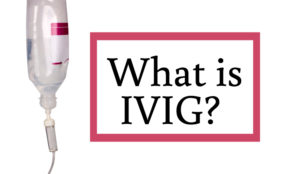What is IVIG?
What Is IVIG? IVIG stands for IntraVenous ImmunoGlobulin. IVIG is a preparation made by pooling immunoglobulin G (IgG) from the plasma of healthy blood donors. Generally, it’s used for the treatment of patients suffering from immunodeficiency disorders.
This type of preparation first became widely available during the second world war and was used to help prevent diseases such as polio, measles, and hepatitis. It was first used as a replacement therapy for people with primary immunodeficiency disorders in 1952 and administered through intramuscular injections. This method of administration limited the doses that could be given because of the small volumes involved and also proved to be painful for patients. This is no longer the case.
The U.S. licensed preparations that could be safely administered intravenously in the early 1980s. Larger doses could be given through the intravenous route and more closely matched the body’s own antibody production. Most patients tolerated this type of treatment well, and it soon became the standard treatment for patients suffering from primary immunodeficiencies with antibody deficiency.

What is IVIG Made Of?
IVIG is manufactured using donor pools from 10,000 to 60,000 units of donated human plasma. They contain immunoglobulin G (IgG) antibodies which fight off a wide variety of infectious agents. There are differences in the exact processes and stabilizing agents that are used from one manufacturer to another, but all IVIG preparations contain more than 96% IgG. Most products also contain some immunoglobulin A and trace amounts of other plasma proteins.
What is IVIG Used for?
Immunoglobulin preparations are currently approved by the FDA to be marketed for the following conditions:
- Primary Humoral Immunodeficiency (Pidd)
- Immune Thrombocytopenia Purpura (Itp)
- Chronic Inflammatory Demyelinating Polyneuropathy (Cidp)
- B-cell Lymphocytic Leukemia
- Kawasaki Syndrome
All IVIG products carry an indication for one of the above disorders, but none of them are indicated for all five.
Off-Label Uses of IVIG
Using a drug for an “off-label” purpose means to use it for something other than what it has been approved for. For example, aspirin is approved to relieve pain or reduce fever, but, because of other properties that aspirin has, many doctors suggest taking one aspirin per day to reduce the risk of heart attack. This would be an off-label use of aspirin.
Immunoglobulin therapy is often used for many different off-label conditions such as:
- Guillain-barré Syndrome
- Polymyositis
- Dermatomyositis
- Multifocal Motor Neuropathy
- Stiff Person Syndrome
- Relapsing-remitting Multiple Sclerosis
- Pemphigus
IVIG has also been used to treat other immune disorders, but results have not been proven on a large enough scale to earn the full acceptance of the medical community at this time.

What Is an Immunodeficiency Disorder?
An immunodeficiency disorder is when the body is unable to properly defend itself against infections and diseases. Someone suffering from this type of disorder is more susceptible to illness and disease than an average person. There are two type of immunodeficiency disorders, primary and secondary.
A primary disorder is one in which the immunodeficiency is caused by something congenital. The deficiency may or may not be present at birth, but it develops as the result of something the person was born with. There are more than 100 known types of primary immunodeficiency disorders.
Secondary disorders, sometimes called acquired disorders, develop later in life. They are caused by environmental factors that weaken the immune system. Some examples of secondary immunodeficiency causes are HIV, chemotherapy, malnutrition, and severe burns.
What is IVIG Treatment for an Immunodeficiency Disorder?
Treatment for immunodeficiency disorders focuses on three main points, regardless of whether it is a primary or secondary disorder:
- Treating and preventing infections
- Boosting the weakened immune system
- Treating the underlying cause of the deficiency
For managing infections, patients may be given antibiotics to fight pathogens as well as other medications to relieve the resulting symptoms, such as decongestants, expectorants, and ibuprofen to reduce pain and fever.
To boost the immune system, IVIG therapy is often used, but treatment may also include gamma interferon therapy and growth factor therapy.
If the immunodeficiency is caused by an underlying serious illness, such as cancer, for example, additional treatment would be specific to that illness.

Talk Your Doctor
What is IVIG? Still want to know more? If your doctor has recommended IVIG treatment, it’s important to follow through with the advice. Speak to your doctor for more information about immunodeficiency disorders, IVIG therapy, and qualified treatment centers near you.


 If you think you might be experiencing side effects as a result of your IVIG therapy, during or after an infusion, let your doctor know right away. Together, you’ll be able to decide the best course of action to help you reduce or eliminate any discomfort and get the best possible benefit from your treatment.
If you think you might be experiencing side effects as a result of your IVIG therapy, during or after an infusion, let your doctor know right away. Together, you’ll be able to decide the best course of action to help you reduce or eliminate any discomfort and get the best possible benefit from your treatment.